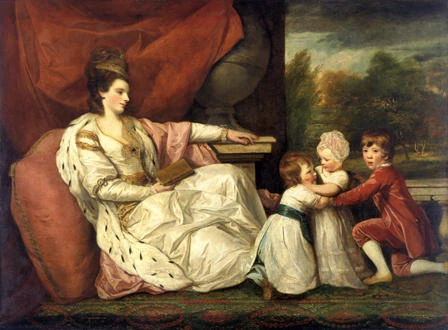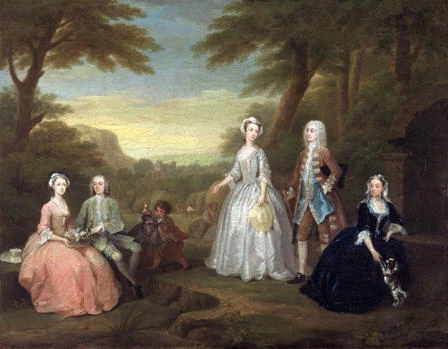Becoming an Artist in the Eighteenth Century
Joshua Reynolds (1723 - 1792), Charlotte (Grenville), Lady Williams-Wynn (1754-1830) and her Children, oil on canvas, purchased with assistance of the Art Fund and the National Heritage Lottery Fund 1998, NMW A 12964
William Hogarth (1697 - 1764), The Jones Family Conversation Piece, 1730, oil on canvas, Purchased with the assistance of the National Heritage Memorial Fund and the Art Fund 1996, NMW A 3978
Richard Wilson (1714 - 1782), Dolbadarn Castle, oil on panel, purchased 1937, NMW A 72
The social status of artists had traditionally been low. To earn the respect of his future clients, an artist needed a good general education, including some knowledge of geometry and of classical history and literature. Many were therefore the sons of middle-class professionals or tradesmen.
An artist's training was still largely based on the traditional apprenticeship system. He became a pupil of an established artist, to whom he paid a fee. In return he was taught the technical skills of preparing paints and canvases, and learnt through example and by carrying out routine tasks.
It was realised that more formal and structured training was also needed, and London had a number of drawing schools. The Welsh painter Thomas Jones attended two of these for eighteen months before beginning a two-year pupilage with Richard Wilson.
Once he had achieved an acceptable level of skill, an artist might find work as a paid assistant, but eventually he had to establish his own practice. If he could afford it, a period of study abroad was a vital stage in developing a career. Nearly two hundred British and Irish artists travelled in Italy during the eighteenth century.
Specialization
Eighteenth-century British artists had to develop a particular skill that would attract customers. They did so by specializing in one of a number of 'branches' of painting. Theorists regarded history paintings, works with morally uplifting messages, often drawn from ancient history, as the 'highest' form of art. In practice the demand for history painting was largely met by the European Old Master paintings collected by the very wealthy.
Most British painters were portraitists, as almost anyone who could afford it had their image taken — in miniature or in chalks or pencil, if an oil painting was too expensive. Reynolds cleverly flattered his aristocratic clients by giving their great portraits a touch of Old Master glamour. Some artists, notably Hogarth, developed the conversation piece of figures interacting in a domestic setting or painted 'fancy' or genre paintings of modern life. Others found a niche in painting animals, ships or flowers
Landscape painting became increasingly popular as people's attitudes to nature changed. From being images of a place, it became a way of expressing ideals and emotions. Richard Wilson specialized in landscapes that conveyed the serenity of the classical world. Others sought to convey the beauty and grandeur they found in nature.
The Emergence of a Profession
To gain status and financial reward, artists had to leave their craft origins behind and establish themselves as professionals. They did this by becoming more highly skilled, but particularly by forming clubs and societies. These promoted members' interests, particularly through exhibitions, and kept out those felt not to be good enough.
A number of leading artists, dissatisfied with the much larger Society of Artists, set up the Royal Academy of Arts in 1768. Membership was limited and by election. Its first President was Sir Joshua Reynolds (1723-1792), portrait painter and theorist, who mixed easily with the elite of the day. The Academy promoted professional status of artists and provide training. Success in its annual exhibition could make an artist's reputation.
The Royal Academy's exhibitions were held in the 'Great Room' at Somerset House from 1780. Pictures were hung from floor to ceiling, and artists schemed to get their works 'on the line' — the potential purchaser's eye level.
An artist also needed suitable premises in a fashionable area, to receive clients and show off his work. These were expensive but the prices that a successful artist could charge also increased sharply. Reynolds at the height of his success charged £200 for a full-length portrait, a sum which was then a middle-class annual salary.


